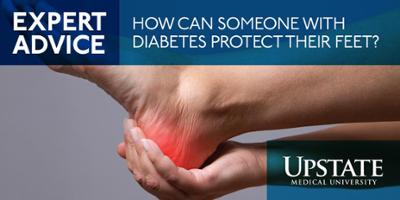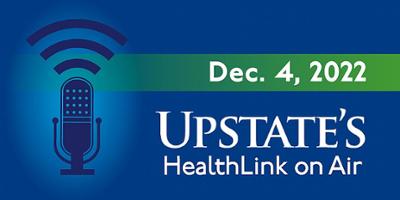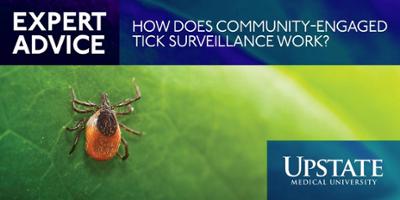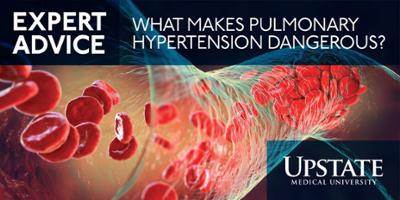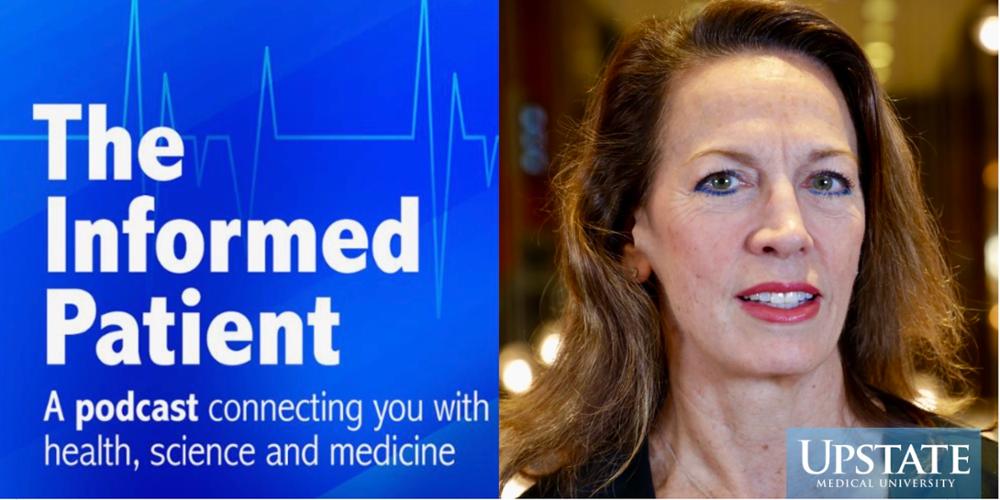
Varicose veins, diabetic foot troubles and other conditions that require a vascular surgeon's care
Transcript
Host Amber Smith: Upstate Medical University in Syracuse, New York, invites you to be The Informed Patient, with a podcast that features experts from Central New York's only academic medical center. I'm your host, Amber Smith.
If you develop a disease that affects your arteries or veins, you may require care from a vascular surgeon.
Here with me to talk about this surgical subspecialty is Dr. Palma Shaw. She's a professor of surgery at Upstate, specializing in vascular surgery, and she'll be the president of the International Society of Endovascular Specialists in 2023.
Welcome back to "The Informed Patient," Dr. Shaw.
Palma Shaw, MD: Thank you so much, Amber. It's really a pleasure to be here today.
Host Amber Smith: Now, do I understand correctly that vascular surgeons like yourself may treat a fair number of patients who don't require surgery?
Palma Shaw, MD: That is true. Not everybody that we see requires a surgical intervention.
Oftentimes, we're there to help diagnose the problem, offer them some counseling and help them modify either their behavior or maybe some of their medications first. And then if that doesn't work, then we can talk about more invasive options.
Host Amber Smith: Let's talk about some of the common problems that patients come to you with.
Peripheral artery disease -- that's one of them. What is peripheral artery disease, and how is it handled, typically?
Palma Shaw, MD: Peripheral arterial disease is generally a narrowing of an artery. We sometimes call it a blockage. It may be partially blocked, maybe 50% blocked, or it could be 100% blocked, and it could be a long blockage or a short blockage in the arteries that go from the groin all the way down to the foot.
Patients at most risk would be those who smoke. Additionally, patients with diabetes are also at higher risk, particularly for blockages in the calf.
Patients who present with peripheral arterial disease may also have other problems in their heart or in their carotid arteries in their neck, so we have to be aware that those patients have other risk factors, and oftentimes those risk factors are modified through medications to try to address their blood pressure and their cholesterol.
In addition to that, we then evaluate the patients and try to determine where these blockages in the arteries may be that are causing the problems that may make them either walk or be unable to walk or develop pain in their foot or an inability to heal a wound over a period of time.
Host Amber Smith: When someone is suspected of having an abdominal aortic aneurysm, is that something where they would be referred to a vascular surgeon?
Palma Shaw, MD: Yes, that is true. They are often referred to us either from their primary care doctor or their cardiologist, and sometimes even the urologist, who may have done a screening ultrasound or an ultrasound to evaluate a different problem, and then an aneurysm is seen.
Additionally, Medicare, for any male that ever smoked cigarettes over the age of 60 can have a screening abdominal ultrasound to try to see if this is present.
Oftentimes, these are asymptomatic, and when they become large, they're a threat to life for that patient.
Host Amber Smith: Now, how do you describe aneurysms for patients? Because I'm not sure everyone understands what an abdominal aortic aneurysm is.
Palma Shaw, MD: The aorta is a tube that comes off of the heart in the chest and looks like a candy cane, actually, coming off and then running down the back in the abdomen, behind the stomach.
And when this becomes enlarged, it may look like a circular enlargement, maybe one or two times the normal size of the artery. And when it reaches a large size, such as 5 centimeters, we start discussing repair options with the patient.
Host Amber Smith: How common is carotid artery disease?
Palma Shaw, MD: Carotid artery disease is fairly common, although we don't see good yield with screening ultrasounds, so we don't look for that disease unless we hear a noise when we listen to the neck or if the patient were to have a symptom.
But generally, when we do detect that, if we hear a noise or if the patient has any symptom, if they have dizziness or weakness or numbness, for example, we may get a carotid ultrasound because one-fifth of all strokes are related to blockages in the carotid arteries that are in the neck.
Host Amber Smith: So that's where plaque builds up in the bloodstream?
Palma Shaw, MD: Yes. I tell patients sometimes it's like if you had your driveway, and you had it repaved, it has an extra layer on it. And if you've ever been on the road in New Hampshire and seen a frost heave, it's sort of a billowing up of the road. Well, the plaque can rupture, almost like volcano appearance, and then a little bit of debris can break loose and then go to the brain, and that's when they become symptomatic.
And a stroke can occur.
Host Amber Smith: Do you care for a lot of people with what's called chronic venous insufficiency?
Palma Shaw, MD: Over 10 million Americans have chronic venous insufficiency. It's an extremely common problem. It's certainly not life threatening, but it is very much a nuisance for a lot of patients. Many of them may feel fatigue in their legs. They may have bulging veins, they may be sore. They eventually may even develop ulcers and wounds on their inner calf that generally results in long-term problems and repeated visits to see the doctor, and those things can affect your work and your day-to-day life.
Host Amber Smith: Is chronic venous insufficiency related to varicose veins?
Palma Shaw, MD: Yes. Oftentimes. Varicose veins are actually one description of the venous insufficiency. It depends where the diseased vein is. So chronic venous insufficiency can be in the deep system or the superficial system. And I tell patients it's as if you had a ladder, and there's two sides to the ladder, and one would be the deep, which is closer to the bone in the leg, and then there's the superficial, and those two rungs of the ladder have the bars in between, and you can walk up the ladder.
Well, that's just like the valves that are in the venous system. And if you go to step on one rung and it breaks through, that's a broken valve in the vein. So as you walk and you pump the blood up, back up towards your heart and the muscles contract, and then as the gravity pulls the blood back, if the valve is broken, that blood will go down to the next functional valve, and if all the valves are broken in the leg, they're crashing down at the ankle level, and that's why you get swelling down in the (lower leg area).
Host Amber Smith: So it sounds like varicose veins, it's not just a cosmetic thing, it's actually a medical issue.
Palma Shaw, MD: It is. There are patients who do have prominent varicose veins that truly have no symptoms, and for the most part just don't like how they look.
For example, patients may have those tiny little spider veins, we also call them reticular veins. And those little spiders the patients don't like the appearance of are cosmetic. They're not covered by most insurances, but patients may perceive that they're giving them discomfort, particularly if there's a large cluster of spider veins in a specific area of their leg, and they may benefit from use of compression stockings.
Host Amber Smith: Now, regarding diabetic foot care, why might a vascular surgeon be involved?
Palma Shaw, MD: Patients with diabetes should pay a lot of attention to their foot care. They often can develop neuropathy, which is disease in the nerves of their foot, and when that happens, they can have sensory or loss of feeling or pain, actually. They can have changes in the distribution of the muscles impacting the bones in their foot, so they get deformity so they don't have the normal composition of the foot, and it may wear incorrectly in a shoe, so they may need special shoes that accommodate the problems of the foot.
And they also have autonomic problems, which is another component, and that means that they don't have good function of the sweat glands, so they get a lot of calluses and dry skin. So the combination of dry skin, which can crack, extra pressure on specific bones in the foot, and then, loss of sensation, put those patients at risk of wounds. And not a little wound, but a wound that may actually go all the way down to the bone and put them at risk of losing their foot and bad infections, depending upon how well the diabetes is controlled. So it's really important that they have a good podiatrist, and they follow with that podiatrist routinely, who's skilled at identifying the changes that keep them out of trouble.
The patients also may develop vascular disease, particularly below the knee in the little vessels called the tibial vessels. There are three, and the diabetics who smoke are at the highest risk of limb loss. We say every 20 minutes a limb is lost in a diabetic in a non-traumatic way. And this is usually related to blockages in the arteries.
And those people who smoke will have blockages above the knee, more often, and then the diabetics will have blockages below the knee. So it's really a double whammy, and it's a huge problem for them, and we try to counsel the patients.
So once the podiatrist or somebody detects that there's a decreased pulsation of the pulse in the foot, that they can't feel the pulse, the patient should see a vascular surgeon, so we can evaluate the patient so that we can keep them out of trouble or potentially have to revascularize them and bring better blood supply to the foot, so the wound that has developed can heal.
Otherwise they could lose their foot.
Host Amber Smith: You helped organize a conference at Upstate recently teaching about limb preservation.
Does that tie into the diabetic foot care?
Palma Shaw, MD: Absolutely, Amber. I recognized a few years ago while I was doing my Master's of Business Administration, that we needed to develop a limb preservation program at SUNY Upstate Medical University. No one else in this region has a limb preservation group, and we have everything we need.
We have an outstanding wound care group. We have diabetology, we have podiatry, we have all the endovascular and vascular specialists that we need. We just needed to bring this together so that we could benefit our local community as well as the surrounding regional hospitals that need care.
So we just held our first limb preservation symposium, which was really successful, and we decided to do it hybrid so that it could reach as far as Albany or as south as Ithaca if people couldn't come.
Host Amber Smith: This is Upstate's "The Informed Patient" podcast. I'm your host, Amber Smith.
I'm talking with Dr. Palma Shaw. She's a professor of surgery at Upstate specializing in vascular surgery, and she was elected to be president of the International Society of Endovascular Specialists starting in 2023. We've been talking about her role as a vascular surgeon, but now we're going to talk to Dr. Shaw about a podcast she's been co-hosting.
I understand you have a podcast with another vascular surgeon from Houston called "Sisterhood in Surgery." Can you tell us about it?
Palma Shaw, MD: Sure. Amber. I'm really happy to do that.
This was actually the idea of one of my colleagues who was the original president of the ISEVS, or the International Society of Endovascular Specialists, Dr. Alan Lumsden, who's the chief of, cardiovascular surgery at Houston Methodist Hospital. And his partner Linda Le and I have started this webinar, which we hold monthly, 10 months of the year.
We started in March of 2020, right at the beginning of the pandemic, when everything pivoted to virtual. Initially he came up with this idea, and we thought, well, let's talk about issues that are interesting to female surgeons. So one issue is being pregnant and being a female surgeon. So we did an episode on that, and then we did one on radiation exposure and being a female vascular surgeon, because in our job, oftentimes we work with radiation, and we have to wear lead. And we have done over 30 different webinars on a variety of topics, some of which are vascular- or medical-related, and some are not.
For example, the one last week was on self-care, mind and body, and we had a yoga instructor and a mindfulness adviser. And we had a really good time with that webinar. And then next month we're doing one with a company called Phairify that Dr. Randy Green (a Syracuse surgeon) has started, trying to help physicians estimate their value and what is our worth. And there's going to be a collaborative effort with one of the big societies in vascular surgery. And so we're going to have them on the show to talk about how vascular surgeons can be more valued for what we do.
So this is something also important to vascular surgeons. It's not exactly medically related, but it's important to our careers.
Host Amber Smith: So it sounds like you get your story ideas or your episode ideas based on things that are important in your life.
Palma Shaw, MD: A lot of the shows are all my life, so I'm a single mother, so we did one on single mothers.
A lot of women have problems with fertility. I didn't, but a lot of women did. So we did one on fertility. I had a fertility specialist. Another one was on women who had challenging pregnancies and complications of pregnancy, and we reached out to different female surgeons, and they were able to talk about what their experiences were, and it was remarkable how that sharing of your experience helps other younger female surgeons feel like they're not alone, and they feel invigorated by the sense of a community of women in surgery.
Host Amber Smith: Do you rehearse before you record the podcast?
Palma Shaw, MD: So we do a run of the show, we come up with the idea, we find the guests. Linda and I are the co-hosts. I Zoom in; Linda's in the studio. And then, the week before, we put down some ideas. We send them to our guests and say, feel free to add whatever you want.
And then we send that out to all of them, and we just sort of run through the questions. It's really informal. We feel like it's our version of "The View." And I want to say, you know, we did one called "Generations of Female Surgeons," and I had Pat Numann, who is emeritus here at SUNY Upstate and founder of Women in Surgery. And I had Leslie Kohman, who is our wellness executive here at Upstate and a thoracic surgeon, and she is the founder of Women in Thoracic Surgery, so we had five different generations of women in surgery on the show.
So we do a lot of fun things.
Host Amber Smith: Do you think most of your listeners are women surgeons?
Palma Shaw, MD: I think some men do listen, and I do actually share the links with the medical students, so our vascular surgery interest group, some men and some women also join in because, for example, we don't always have women's topics.
So I did one on how to become an editor of the Journal of Vascular Surgery because people say it's a male-dominated field. They don't have enough women that are editors of the Journal of Vascular Surgery, but I felt bad for the editors that I'm actually friends with. So I said, let's bring them on the show. Let them talk about the women that they have promoted. Let them talk about how women can get more engaged, or anybody can get engaged to become, and now I just became, an editor of the Journal of Vascular Surgery, so I'm practicing what I preach, so to speak.
Host Amber Smith: Do you think circumstances have changed for women in surgery since you got out of medical school?
Palma Shaw, MD: Most certainly, I think we have a way to go, but I personally can say that I've been incredibly blessed, particularly in the last several years with numerous leadership roles. I started the women's section with a colleague, Audrey Duncan, and two other women for the Society for Vascular Surgery. We just started that early this year.
And I have a big role at the Society for Vascular Surgery right now and many other societies, and I feel like I've been given opportunities that I never thought I would ever have had, and I know we have more to go, and there are some women who still feel like things aren't entirely perfectly fair, but how fast can you actually change things?
I think it's like turning around the Titanic. I mean, you can only move so fast, right? But as long as you're making progress and be positive, which I think is really, really important. You know, Amber, Linda and I make a strong effort on the show to always keep things very positive. There's just no point in getting deviated to anything negative. We try to look towards the future in a positive way.
So I think that women in surgery need to still struggle with certain things. I get that. But men struggle, too. But we have to be positive and support each other because the era where women did not support women, and that was not so long ago. When I graduated there were women who didn't support me, but I was fortunate to meet Pat Numann and Leslie Kohman, and they supported me. And now, I think, most women feel like you have to support other women. It's unacceptable not to.
Host Amber Smith: Well, Dr. Shaw, thank you for making time for this interview.
Palma Shaw, MD: Thank you.
Host Amber Smith: My guest has been Dr. Palma Shaw, a professor of surgery at Upstate who specializes in vascular surgery, and the incoming president of the International Society of Endovascular Specialists. The Informed. Patient is a podcast covering health, science, and medicine, brought to you by Upstate Medical University in Syracuse, New York, and produced by Jim Howe.
Find our archive of previous episodes at upstate.edu/informed. This is your host, Amber Smith, thanking you for listening.

